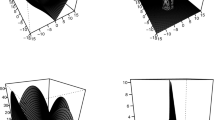Abstract
At least four approaches have been used to estimate communalities that will leave an observed correlation matrixR Gramian and with minimum rank. It has long been known that the square of the observed multiple-correlation coefficient is a lower bound to any communality of a variable ofR. This lower bound actually provides a “best possible” estimate in several senses. Furthermore, under certain conditions basic to the Spearman-Thurstone common-factor theory, the bound must equal the communality in the limit as the number of observed variables increases. Otherwise, this type of theory cannot hold forR.
Similar content being viewed by others
References
Golub, G. H. On the number of significant factors as determined by the method of maximum likelihood. (Stencilled) Digital Computer Laboratory, Univ. of Illinois, 1954.
Guttman, L. Multiple rectilinear prediction and the resolution into components.Psychometrika, 1940,5, 75–99.
Guttman, L. Image theory for the structure of quantitative variates.Psychometrika, 1953,18, 277–296.
Guttman, L. Some necessary conditions for common-factor analysis.Psychometrika, 1954,19, 149–161.
Guttman, L. A new approach to factor analysis: the radex. In Paul F. Lazarsfeld (ed.), Mathematical thinking in the social sciences, Glencoe, Ill.: Free Press, 1954.
Guttman, L. The determinacy of factor score matrices, with implications for five other basic problems of common-factor theory.Brit. J. stat. Psychol., 1955,8, 65–81.
Rao, C. R. Estimation and tests of significance in factor analysis.Psychometrika, 1955,20, 93–111.
Thurstone, L. L. Multiple-factor analysis. Chicago: Univ. Chicago Press, 1947.
Author information
Authors and Affiliations
Additional information
This research was facilitated by a grant from the Lucius N. Littauer Foundation to the American Committee for Social Research in Israel in order to promote methodological work of the Israel Institute of Applied Social Research.
Rights and permissions
About this article
Cite this article
Guttman, L. “Best possible” systematic estimates of communalities. Psychometrika 21, 273–285 (1956). https://doi.org/10.1007/BF02289137
Received:
Revised:
Issue Date:
DOI: https://doi.org/10.1007/BF02289137




